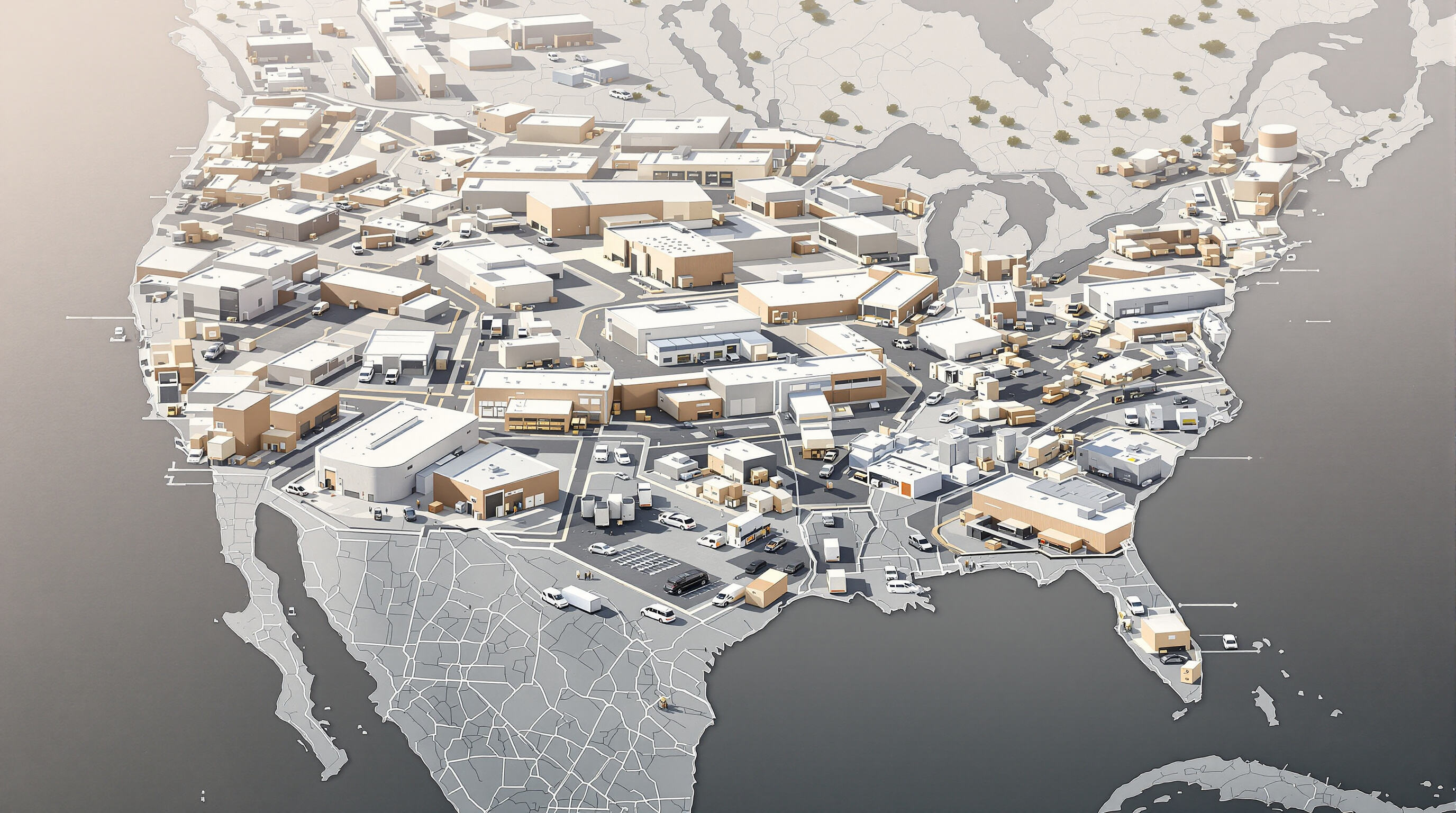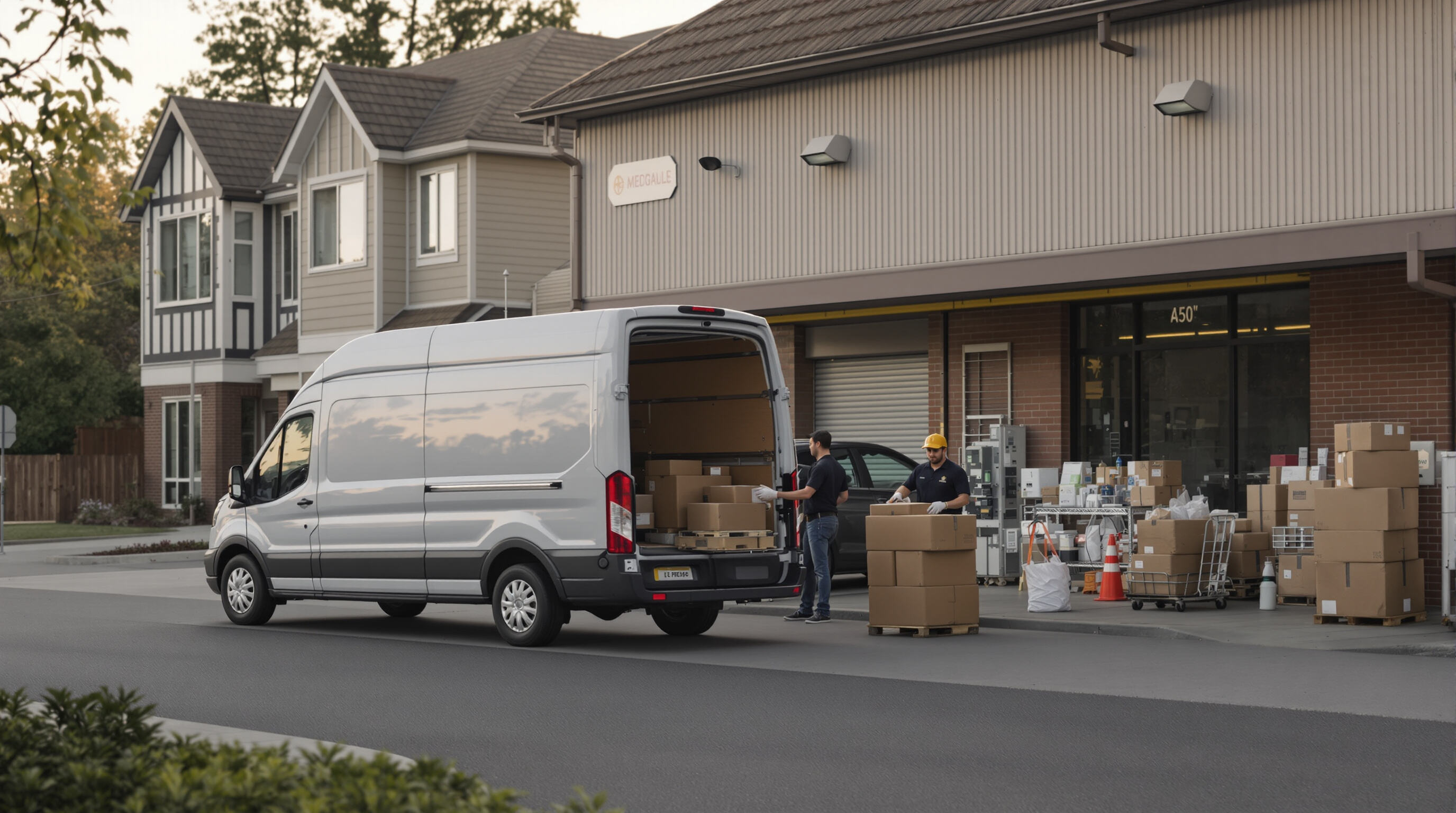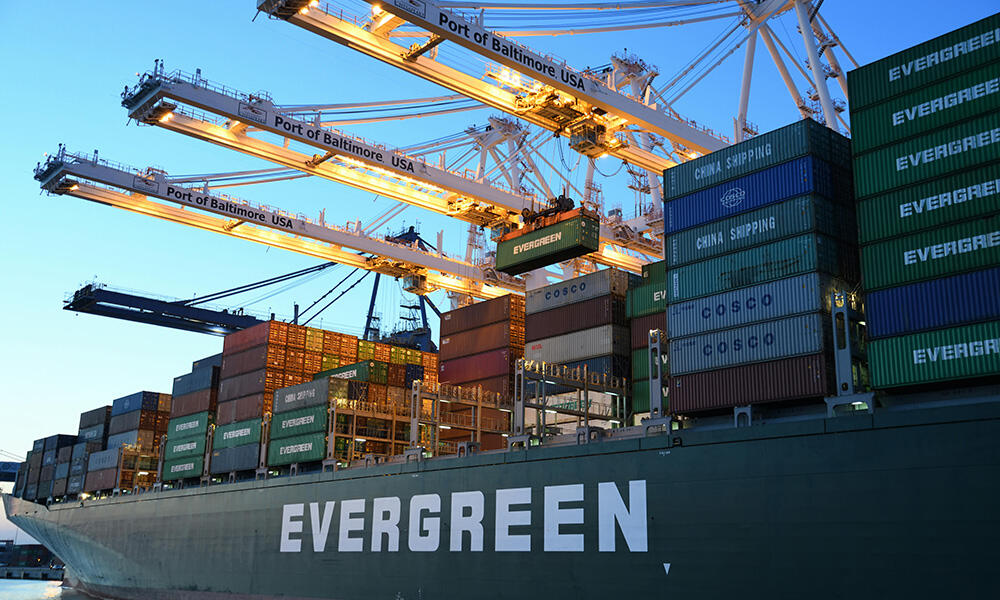Accelerating Delivery Speeds Through Strategic Warehouse Placement

How warehouse placement and delivery speed are directly linked
Strategic warehouse placement cuts last-mile delivery distances by an average of 180 miles for urban consumers (Supply Chain Quarterly 2024). Companies using regional American Ecommerce Distribution Warehouse networks achieve 32% faster order processing times compared to single-location models. This geographic optimization reduces transportation bottlenecks while maintaining inventory flexibility.
Proximity to major markets reduces transit times and delays
Warehouses within 50 miles of metropolitan areas experience 45% fewer weather-related delivery disruptions. Urban micro-fulfillment centers enable same-day deliveries to 72% of city residents versus 18% in suburban zones. This infrastructure alignment prevents costly cross-country shipments that account for 63% of delayed orders.
Shorter shipping distances enable faster, more predictable deliveries
Every 100-mile reduction in shipping distance decreases fuel costs by 14% and carbon emissions by 19% (Logistics Tech Journal 2023). Regional distribution hubs achieve 98.4% on-time delivery rates compared to 82.1% for centralized warehouses. This localization strategy transforms 3-5 day shipments into overnight deliveries for 58% of the US population.
Case study: Regional warehousing improves 2-day delivery performance by 40%
A national apparel brand reduced average transit times from 3.7 to 2.1 days after implementing three strategic Midwest warehouses. This $2.8M infrastructure investment yielded $9.3M in annual savings through reduced expedited shipping costs and 23% fewer inventory stockouts.
American Ecommerce Distribution Warehouse networks and their role in rapid fulfillment
Multi-node warehouse systems now handle 67% of next-day deliveries for top US retailers. These networks utilize real-time inventory tracking to automatically route orders from the nearest fulfillment center, cutting 14–19 hours from standard delivery windows. Advanced systems dynamically redistribute 18% of inventory weekly based on predictive demand algorithms.
Reducing Shipping and Last-Mile Costs with Regional Distribution

For online retailers looking to cut down on shipping costs without sacrificing what customers expect from their orders, regional distribution networks are now pretty much essential. When companies position their warehouses closer to where people actually live and work, taking into account both local buying habits and what carriers charge in different areas, they can save between 19 to 28 percent on getting products out the door compared to having everything shipped from one big central location according to Supply Chain Digest in 2025. What makes this strategy so effective? Well, most delivery money goes towards that final stretch from neighborhood depot to front door. The Parcel Industry Report from 2025 points out that around half again as much of the total delivery cost comes from just getting packages across town or up a street.
Strategic Warehouse Placement to Minimize Overall Shipping Expenses
Locating distribution centers within 150 miles of major metropolitan areas reduces average ground shipping distances by 37%, cutting fuel costs and transit fees. A 2024 analysis found companies using regional fulfillment hubs saved $2.10 per order on dimensional weight charges compared to single-warehouse operations.
Lowering Last-Mile Delivery Costs Through Urban and Suburban Warehouse Proximity
Urban fulfillment nodes positioned inside major transportation corridors enable 4-hour delivery windows while reducing final-mile costs by 32%. The same warehouses decrease residential delivery attempt failures by 19% through optimized evening/nighttime dispatch schedules.
Optimizing Shipping Zones to Access Lower Carrier Rate Tiers
Zone skipping strategies allow bulk shipments to bypass expensive postal zones by consolidating freight at regional hubs. This technique lowers per-package handling costs by 18% while qualifying volume-based carrier discounts:
| Zone Skipping Benefit | Cost Reduction Impact |
|---|---|
| Bulk freight consolidation | 12–15% |
| Postal zone optimization | 8–10% |
| Carrier tier qualification | 5–7% |
Cost Comparison: Centralized vs. Multi-Node American Ecommerce Distribution Warehouse Models
The shift from single-hub to multi-node networks demonstrates clear financial advantages:
| Metric | Centralized Model | Multi-Node Model |
|---|---|---|
| Avg. Cost per Shipment | $8.50 | $5.20 |
| 2-Day Delivery Coverage | 45% | 82% |
| Overage Fee Avoidance | 12% | 94% |
Inventory Distribution Across Regional Hubs to Balance Cost and Speed
Advanced allocation algorithms maintain 98% SKU availability across regional warehouses while keeping safety stock levels 22% below traditional models. This precision reduces inventory carrying costs by $0.38 per unit while supporting same-day fulfillment for 73% of orders.
Meeting Rising Ecommerce Delivery Expectations in the US Market
Consumer Demand for Same-Day and Next-Day Delivery in American Ecommerce
Speed has become king in today's shopping world. Retail leaders tell us that around 85 percent of them have noticed customers wanting things delivered much quicker than before, especially since 2019 according to the latest Ecommerce Trends data from 2024. We can thank Amazon for this change in behavior too. Studies show nearly two thirds of online shoppers will just walk away from their cart completely if same day shipping isn't an option. Big cities such as New York City and LA basically assume packages should arrive within a day these days. This expectation is forcing stores everywhere to completely overhaul how they handle getting products out the door and into customers' hands.
How Regional American Ecommerce Distribution Warehouses Fulfill Speed Expectations
Proximity-driven networks reduce last-mile transit by 35–50% compared to centralized hubs. For example, placing warehouses within 50 miles of Boston or Chicago enables next-day delivery for 92% of metro-area residents. Advanced analytics optimize inventory allocation, ensuring high-demand products are staged closer to dense customer clusters.
Aligning Warehouse Locations with Customer Density and Buying Patterns
Data-driven site selection prioritizes regions with above-average ecommerce spending per household, concentrations of priority customer demographics, and high-frequency purchasing patterns—such as apparel in coastal cities and tech in suburban areas. Predictive modeling helps balance regional specialization with flexibility, a critical advantage when consumer preferences shift seasonally.
Balancing Investment in Micro-Fulfillment Centers vs. Regional Distribution Hubs
While micro-fulfillment centers improve urban same-day capabilities, regional American Ecommerce Distribution Warehouses provide broader coverage at 40% lower operating costs per order. Leading networks use a 3:1 ratio—three regional hubs supporting each metro-area micro-site—to maintain speed without sacrificing scalability.
Leveraging Transportation Infrastructure for Supply Chain Efficiency
Strategic Benefits of Locating Warehouses Near Major Highways, Rail, and Ports
Being close to main transportation routes can cut down on delivery times quite a bit, maybe around 18 to 32 percent when compared to facilities sitting all alone somewhere (according to Logistics Insights from last year). Most big logistics companies try to set up their warehouses no more than about 15 miles away from where highways meet and near those big rail yards. This makes it much easier to get stuff moved out the same day it arrives. For businesses near coastal ports, there's another advantage too. Containers coming off ships can go straight into nearby warehouses without needing extra trucking first. This saves money on transportation costs, roughly $3.80 for every mile saved when bringing in foreign products.
Reducing Inbound and Outbound Transportation Costs Through Transport Hub Proximity
Putting stock closer to places where different transportation modes meet can really cut down on long haul shipping costs when combining trucks, trains, and barges all in one go. Some research from last year showed that businesses which set up cross docking operations right at these transportation crossroads managed to bring their average cost per pallet down around 22 percent. Another big plus? The whole last mile delivery problem gets a lot simpler too. Warehouses located about 50 miles away from city centers are hitting nearly 97% next day delivery success rates without having to pay those extra fast delivery charges that carriers normally tack on.
Supporting High-Volume Logistics with Multi-Warehouse Industrial Distribution Networks
American ecommerce distribution warehouses that really stand out tend to rely on predictive analytics when it comes to balancing their inventory between different regions. Take one auto parts company as an example they managed to cut down on expedited shipping requests by around 40% once they set up three main hubs stretching along major highways like I-35, I-75, and I-95. The whole point of spreading things out this way is pretty straightforward: most customers get what they need within two days flat across nearly the entire lower 48 states. And there's another benefit too transportation costs dropped by almost three million dollars each year for this particular business. Makes sense really, right? Getting products closer to where people actually live saves money and time for everyone involved.
Data-Driven Site Selection for Optimal Warehouse Network Design
Using Demographics, Traffic Flow, and Fulfillment Data to Guide Warehouse Siting
When figuring out where to place American Ecommerce Distribution Warehouses, businesses need to look at several key factors first. The main ones include how people are spread out across different areas since around two thirds of all online shopping happens in big city centers. They also check how much truck traffic moves along major highways every day, plus they review past records of how long orders take to get fulfilled. According to research from last year's supply chain reports, companies that consider these three aspects together cut down their final delivery expenses by roughly a fifth when compared to those who only focus on one factor for choosing warehouse sites. Looking at live traffic data can make a real difference too. Warehouses situated close to the busy I-95 route in the Northeast tend to ship goods to customers east of the Mississippi River about 40 percent quicker because there are multiple roads leading into these areas, so trucks aren't stuck waiting at congested intersections.
Predictive Modeling for Forecasting Demand and Warehouse Scalability
Smart machine learning systems now handle around 15 different factors when predicting what inventory regions will need next month. They look at things like when people tend to buy certain products during seasons, how the local economy is doing, and where competitors have their warehouses stocked. Some companies actually tested these prediction tools in their own facilities and saw a pretty big drop in overstock situations about 35% less waste in some test locations. What makes these models really useful is that they allow for flexible warehouse planning. Warehouses built with roughly 20 to 25 percent of their floor space that can be rearranged work much better during sudden spikes in demand than those stuck with rigid layouts from day one.
Evaluating Long-Term ROI in Warehouse Infrastructure Using Location Analytics
When looking at warehouse locations, companies need to weigh costs against returns. Urban satellite distribution centers typically pay much more for leases but manage to turn over inventory 18 to 22 percent faster than other options. Meanwhile, those big regional hubs can take advantage of cheaper land prices and save around 12 to 15 percent on transportation expenses. According to recent studies by a major logistics research company, facilities chosen with advanced AI location modeling tools stay at about 94% capacity utilization compared to just 78% for sites picked based on gut feeling alone. The latest developments in warehouse management include real time data feeds from all sorts of connected devices throughout the supply chain network. These sensor networks refresh location intelligence models every three months or so, giving managers the ability to tweak their operations as consumer demand patterns shift across different geographic areas.
FAQ
Why is strategic warehouse placement important for delivery speeds?
Strategic warehouse placement is crucial for reducing last-mile delivery distances and transportation bottlenecks, which directly affects order processing times and delivery speeds.
How can warehouses near major markets impact transit times?
Warehouses positioned near major markets reduce transit times by minimizing distance, thus lowering the risk of weather-related delivery disruptions and costly cross-country shipments.
What are the benefits of shorter shipping distances?
Shorter shipping distances decrease fuel costs and carbon emissions, leading to higher on-time delivery rates and faster shipping times.
How do American Ecommerce Distribution Warehouse networks support rapid fulfillment?
These networks utilize real-time inventory tracking and advanced systems to automatically and efficiently route orders from the nearest fulfillment center.
What cost savings do regional distribution networks offer compared to centralized warehouses?
Regional distribution networks can save between 19-28% on shipping costs by positioning warehouses closer to consumers, thus significantly reducing last-mile delivery costs and exploiting lower carrier rate tiers.
Table of Contents
-
Accelerating Delivery Speeds Through Strategic Warehouse Placement
- How warehouse placement and delivery speed are directly linked
- Proximity to major markets reduces transit times and delays
- Shorter shipping distances enable faster, more predictable deliveries
- Case study: Regional warehousing improves 2-day delivery performance by 40%
- American Ecommerce Distribution Warehouse networks and their role in rapid fulfillment
-
Reducing Shipping and Last-Mile Costs with Regional Distribution
- Strategic Warehouse Placement to Minimize Overall Shipping Expenses
- Lowering Last-Mile Delivery Costs Through Urban and Suburban Warehouse Proximity
- Optimizing Shipping Zones to Access Lower Carrier Rate Tiers
- Cost Comparison: Centralized vs. Multi-Node American Ecommerce Distribution Warehouse Models
- Inventory Distribution Across Regional Hubs to Balance Cost and Speed
-
Meeting Rising Ecommerce Delivery Expectations in the US Market
- Consumer Demand for Same-Day and Next-Day Delivery in American Ecommerce
- How Regional American Ecommerce Distribution Warehouses Fulfill Speed Expectations
- Aligning Warehouse Locations with Customer Density and Buying Patterns
- Balancing Investment in Micro-Fulfillment Centers vs. Regional Distribution Hubs
- Leveraging Transportation Infrastructure for Supply Chain Efficiency
- Data-Driven Site Selection for Optimal Warehouse Network Design
-
FAQ
- Why is strategic warehouse placement important for delivery speeds?
- How can warehouses near major markets impact transit times?
- What are the benefits of shorter shipping distances?
- How do American Ecommerce Distribution Warehouse networks support rapid fulfillment?
- What cost savings do regional distribution networks offer compared to centralized warehouses?

